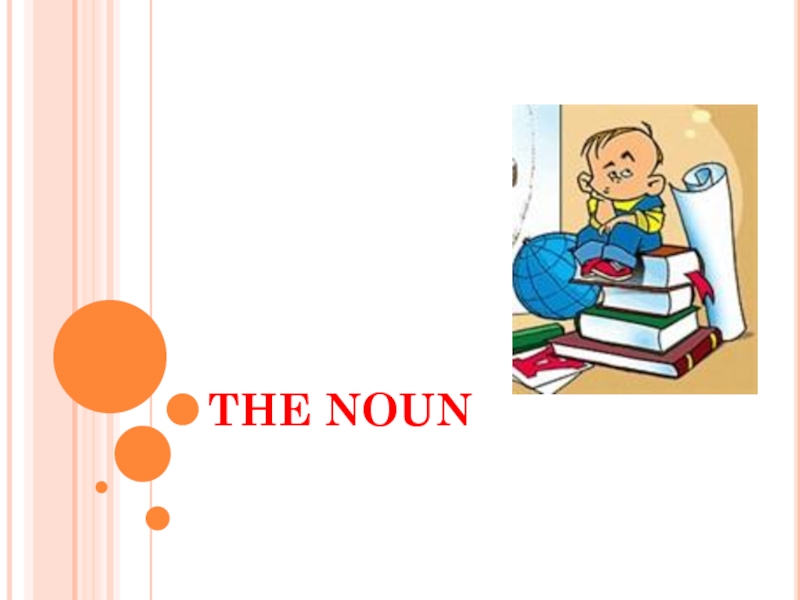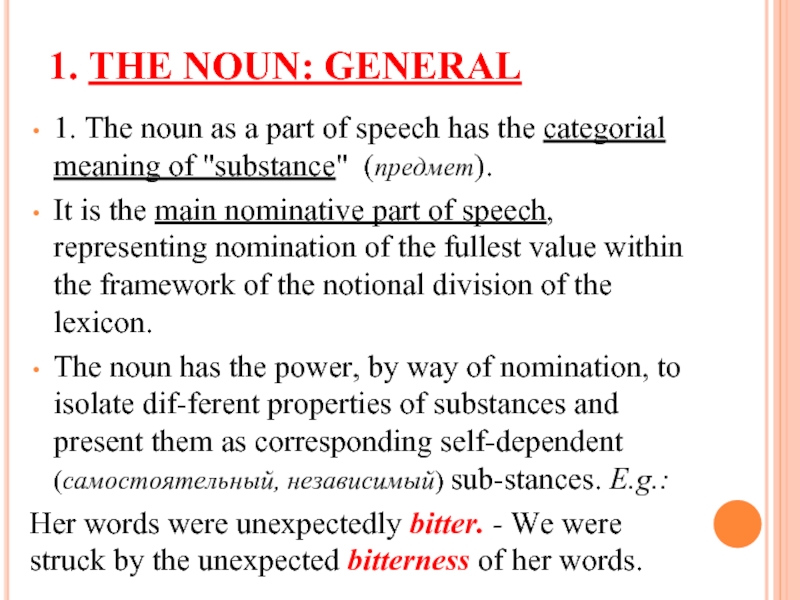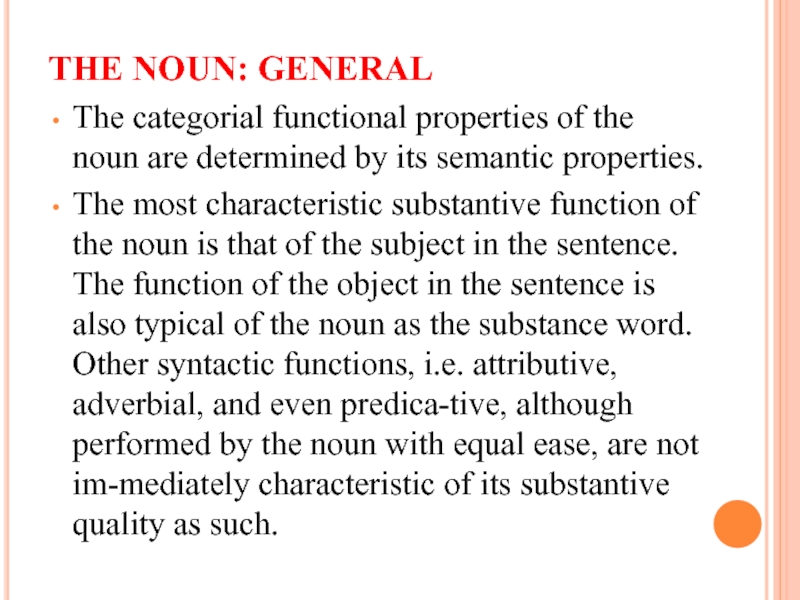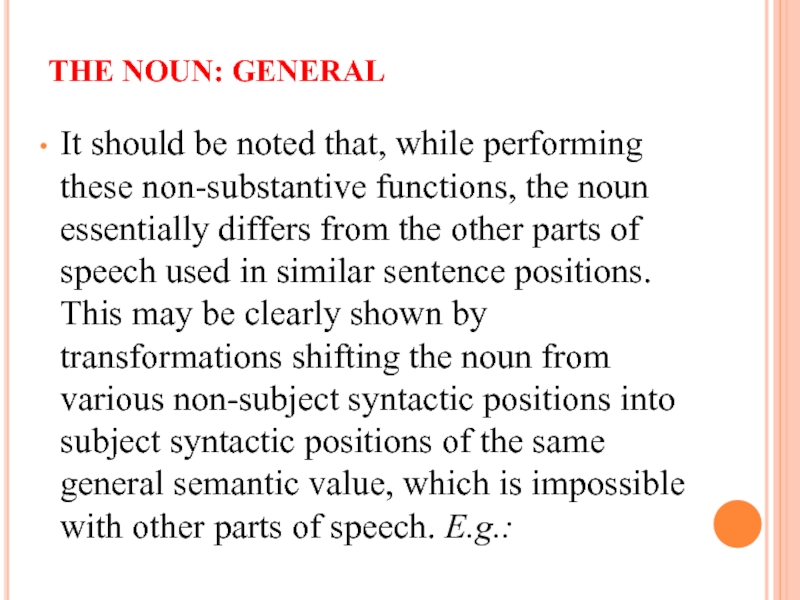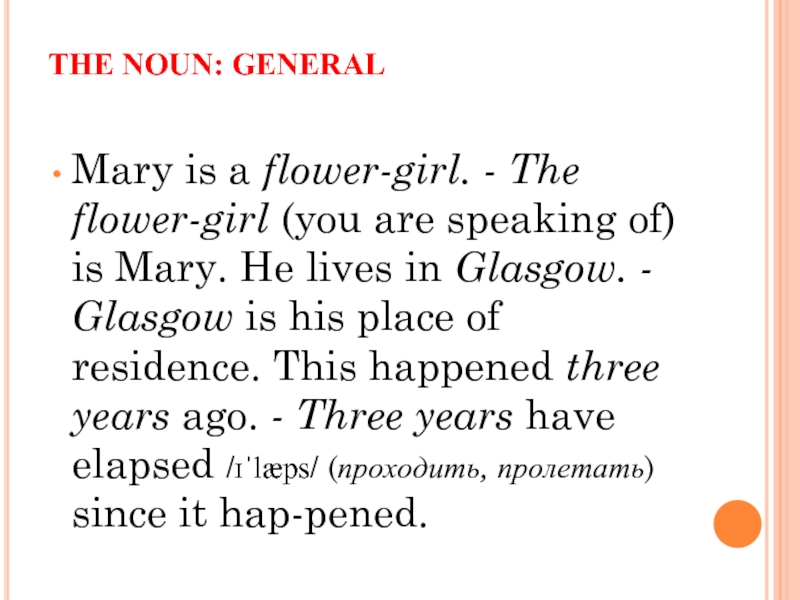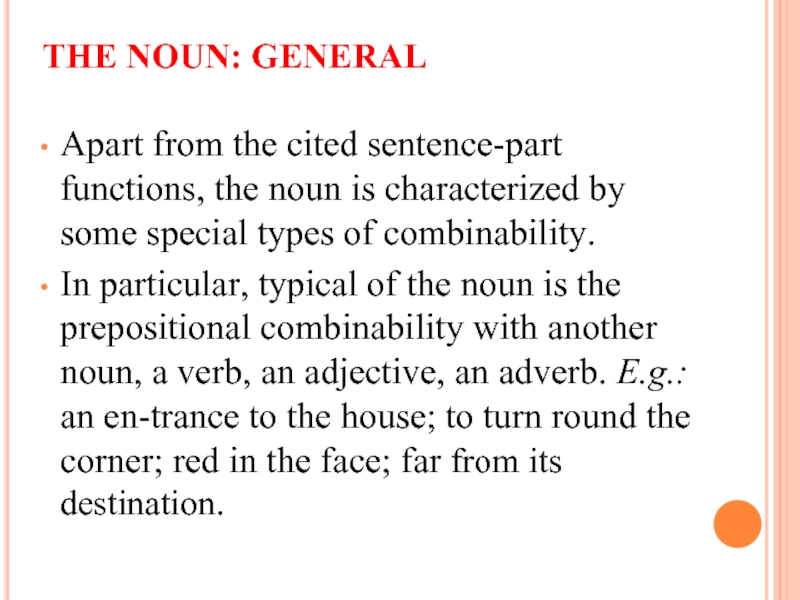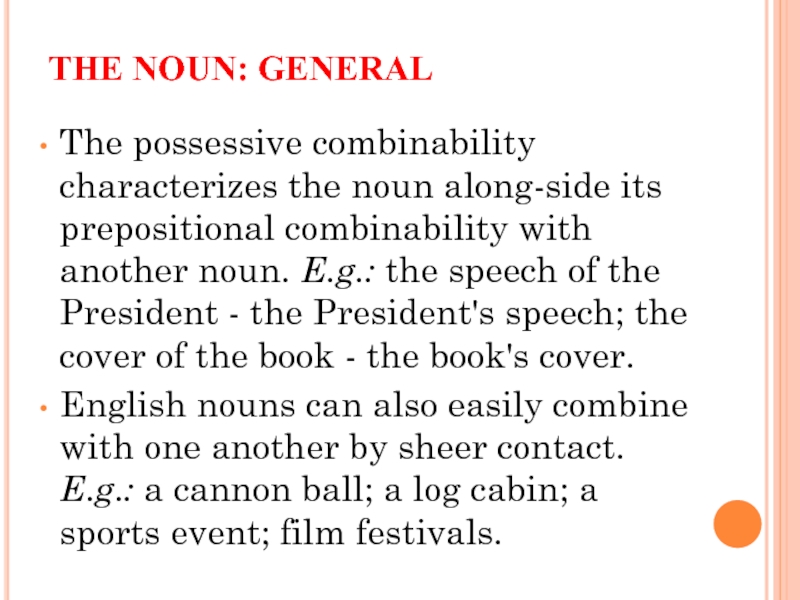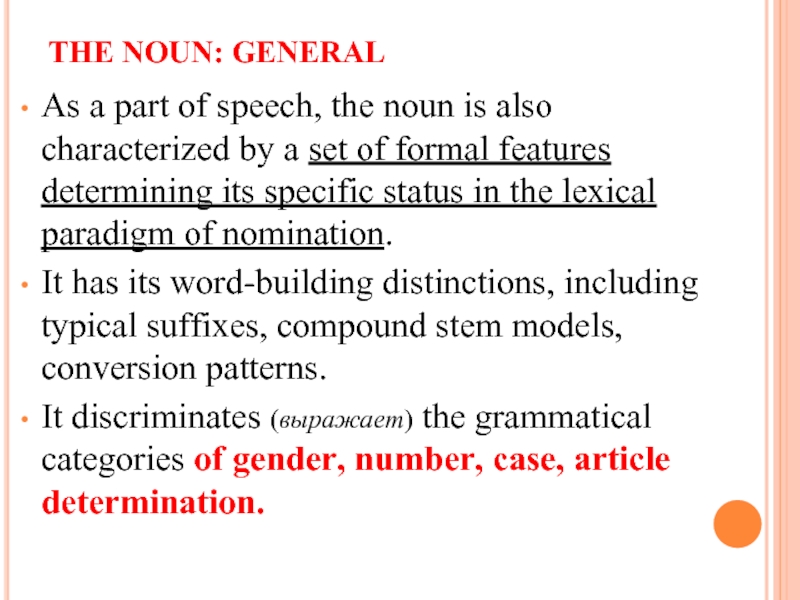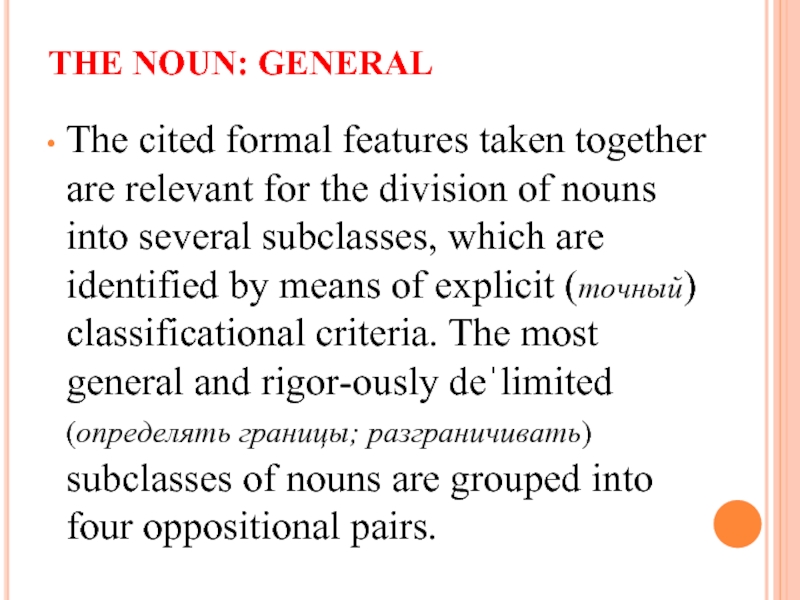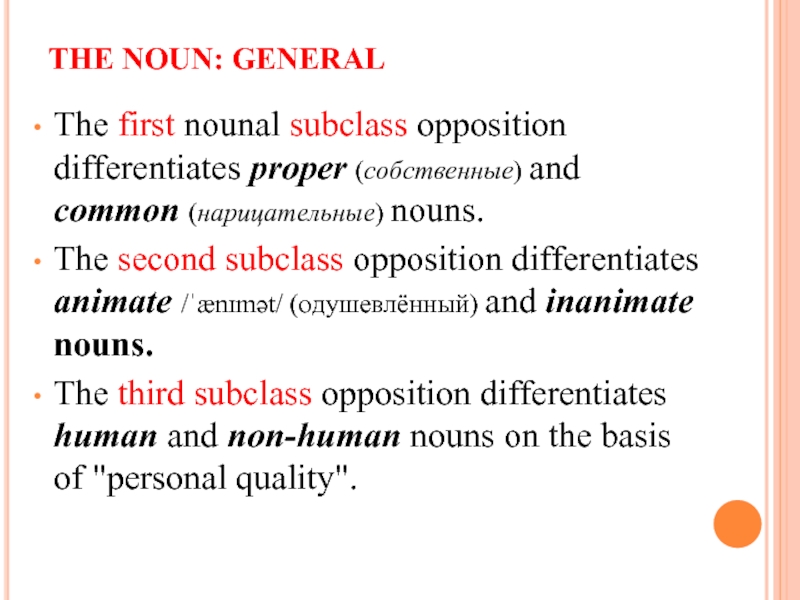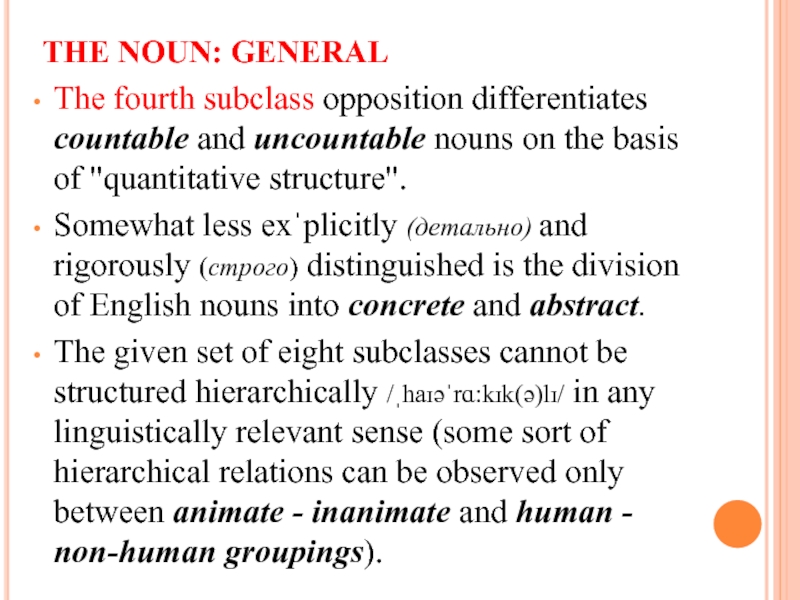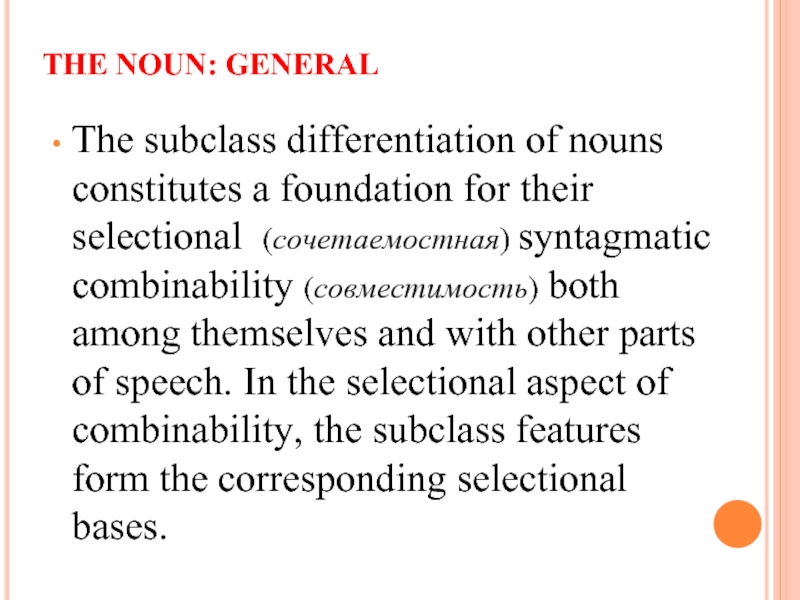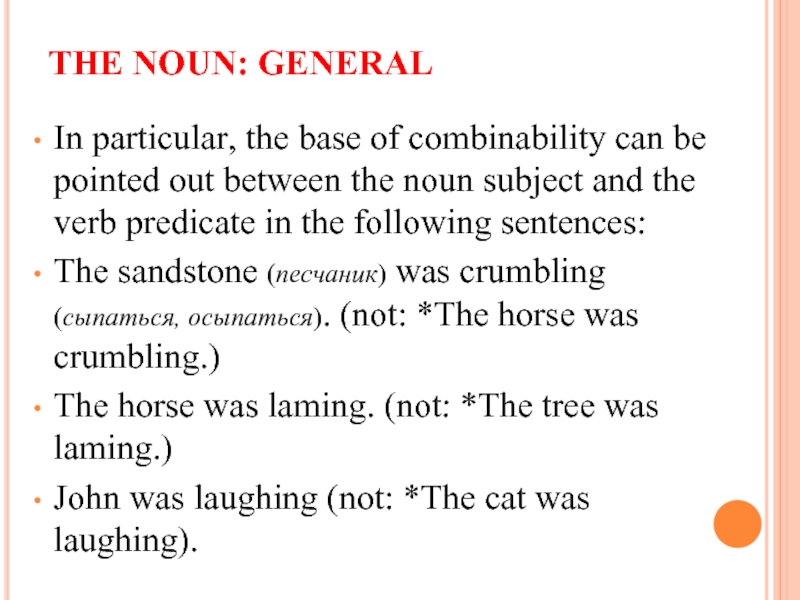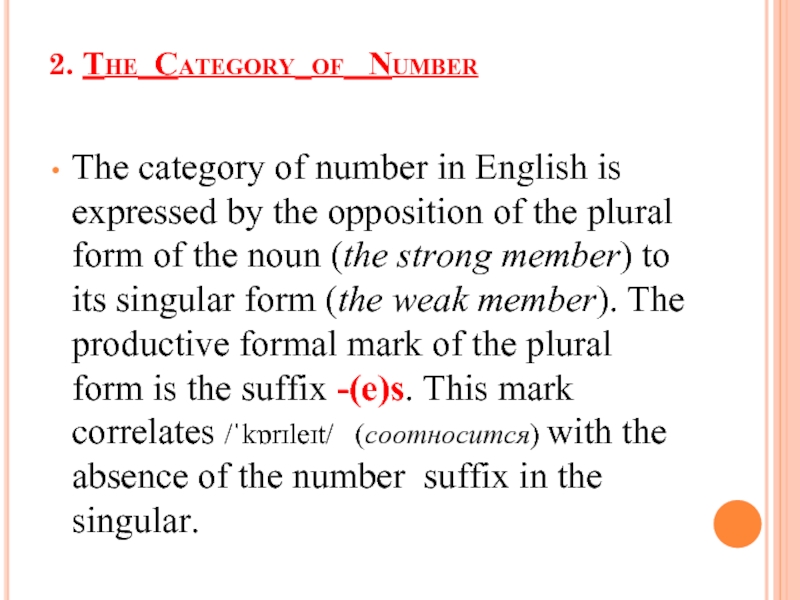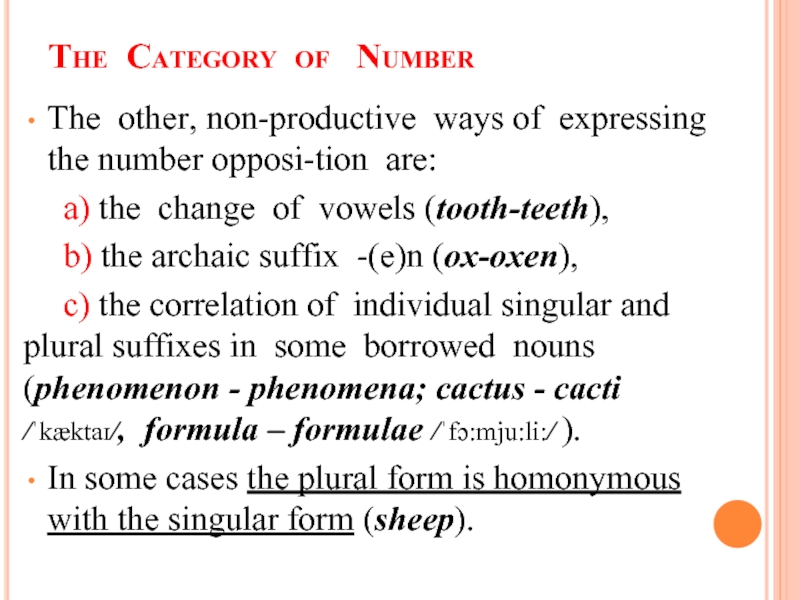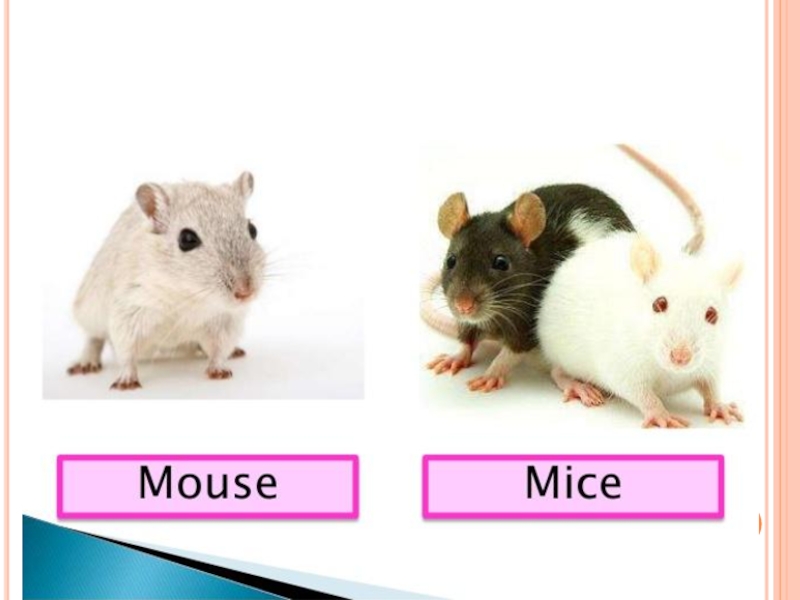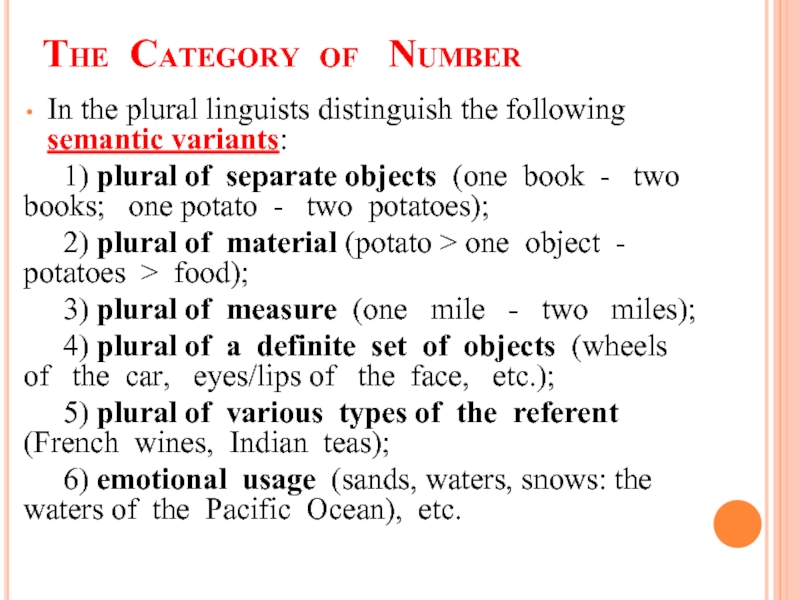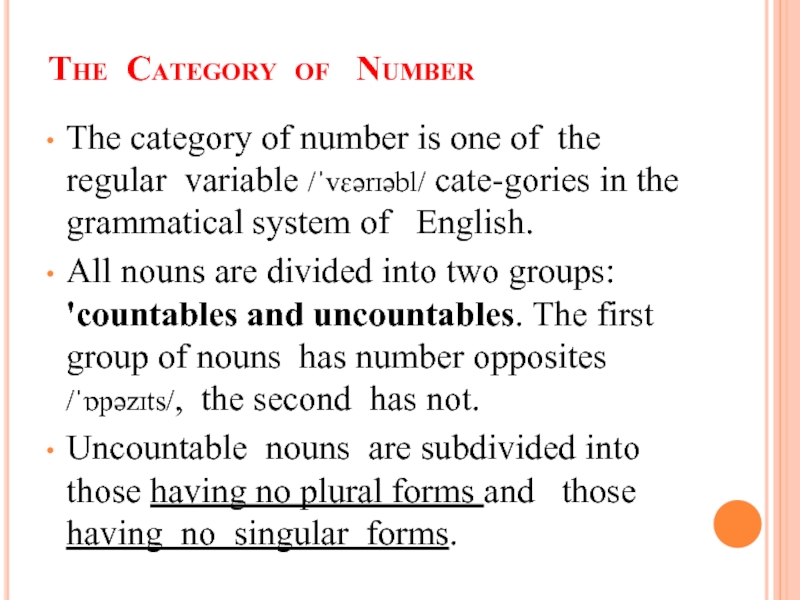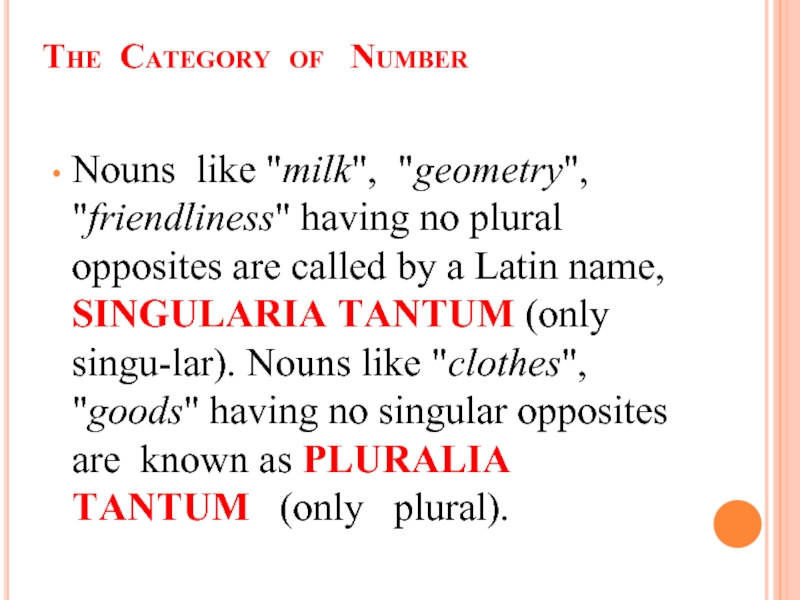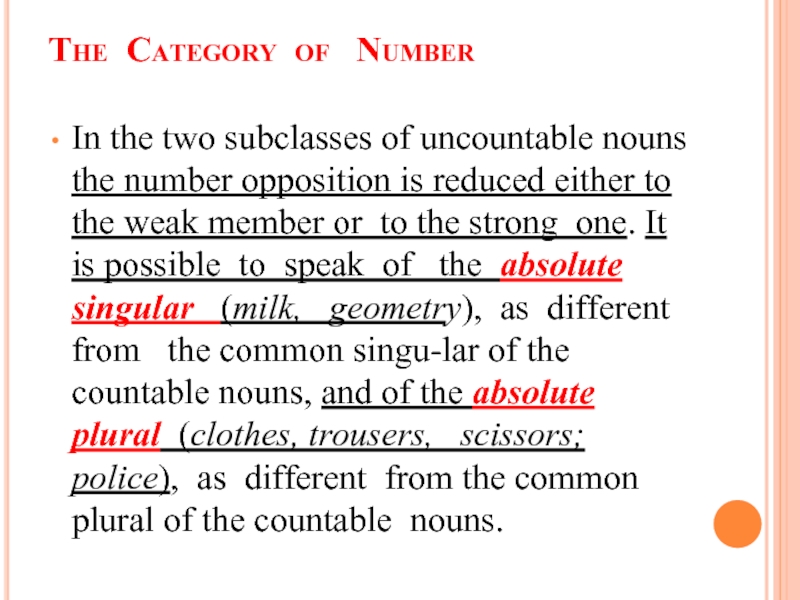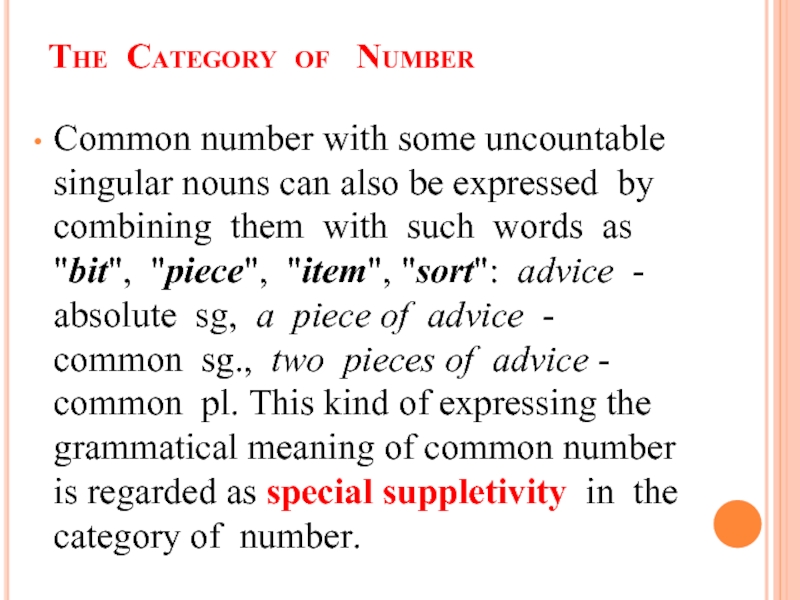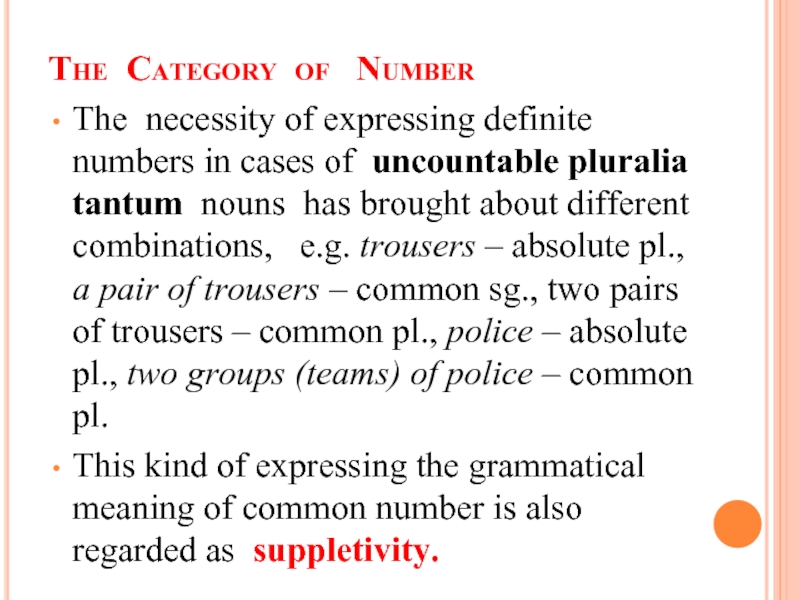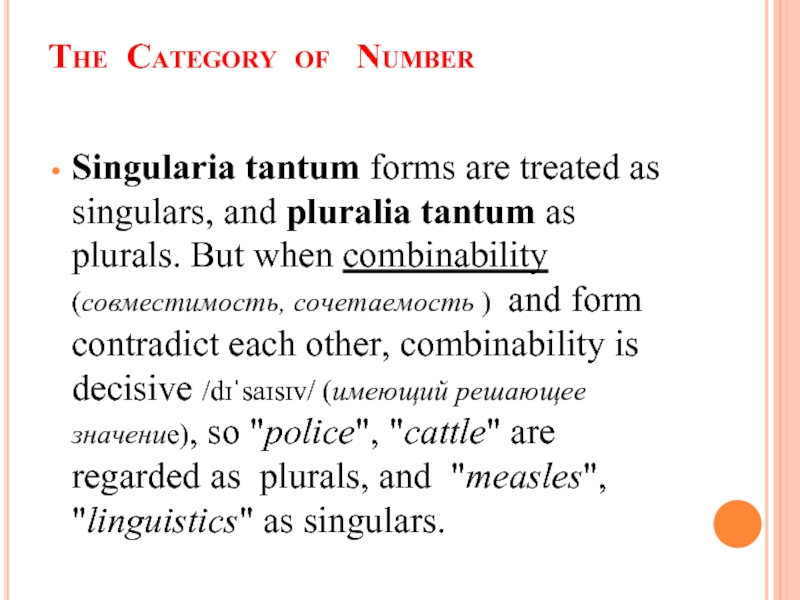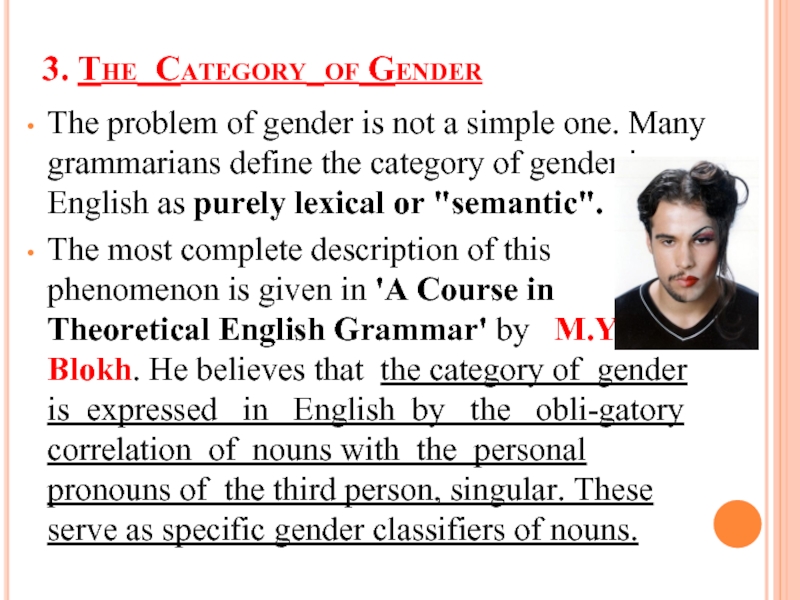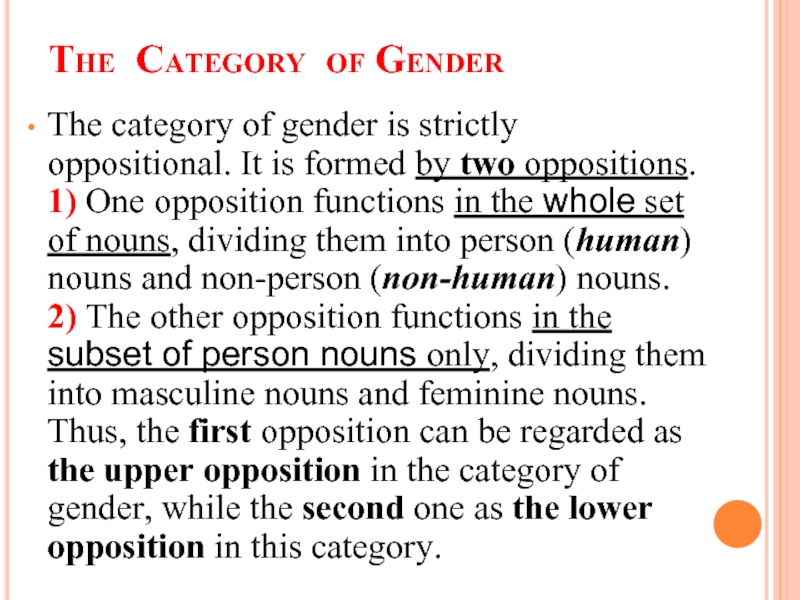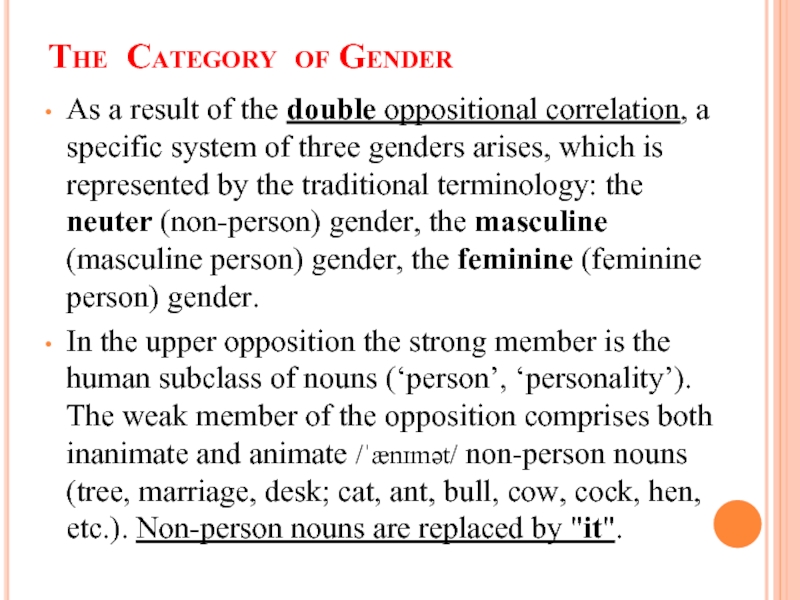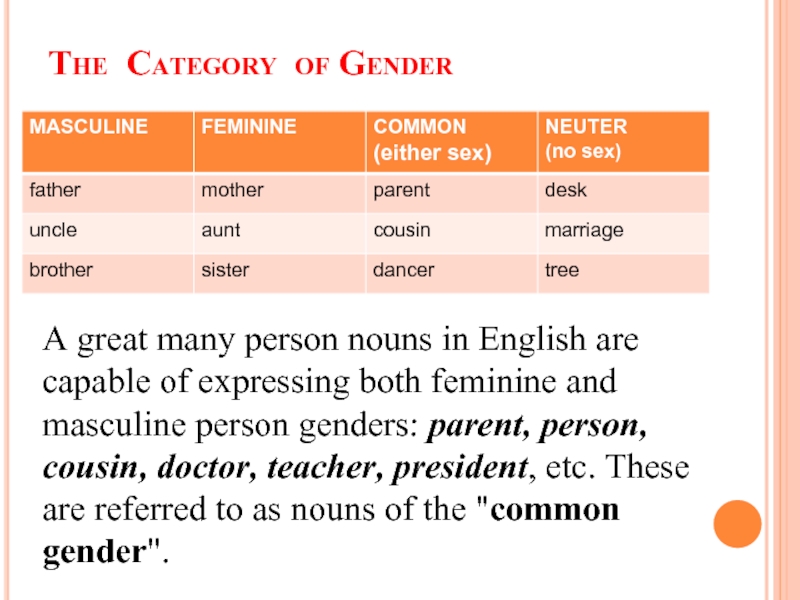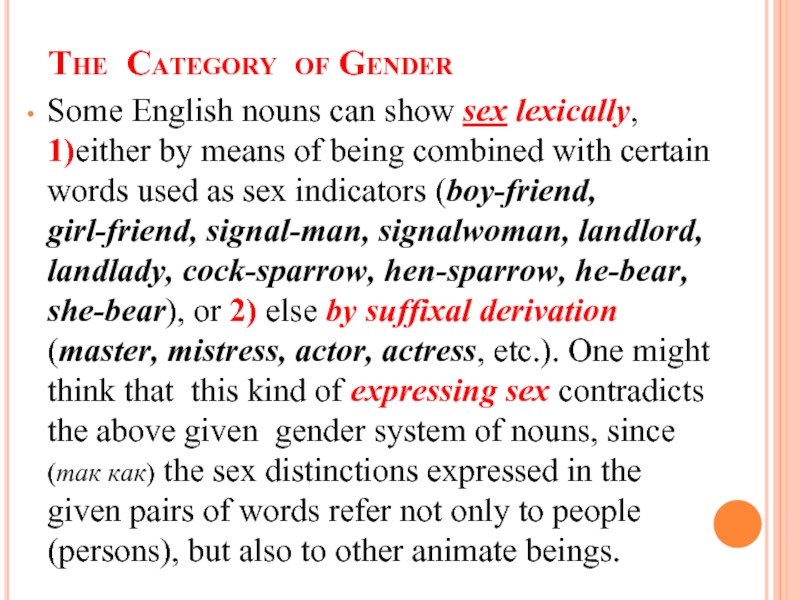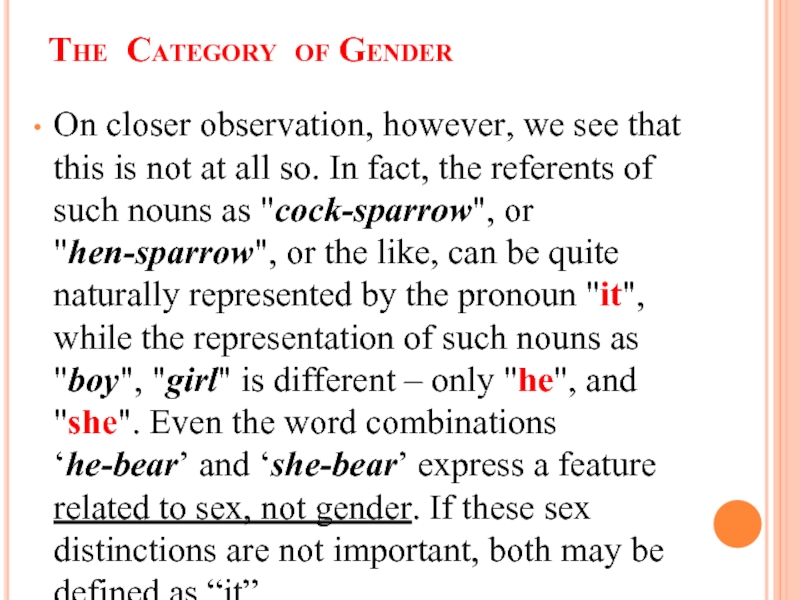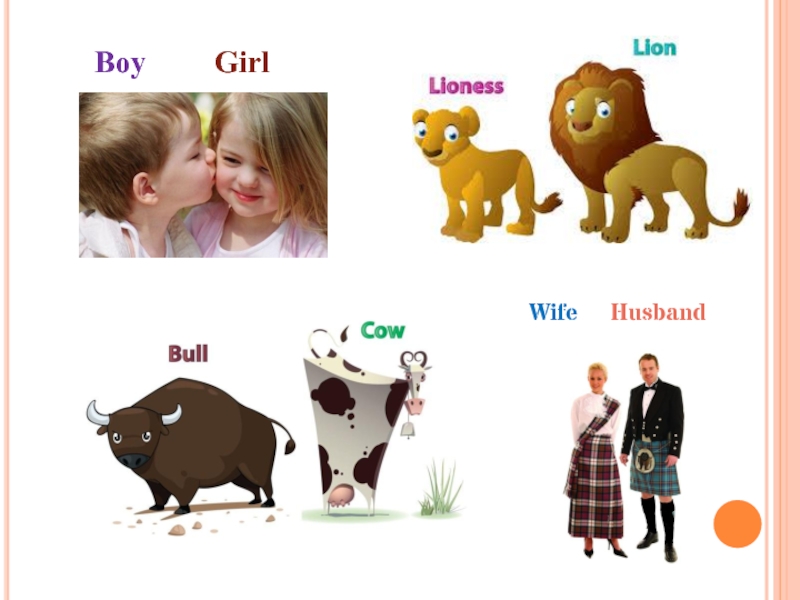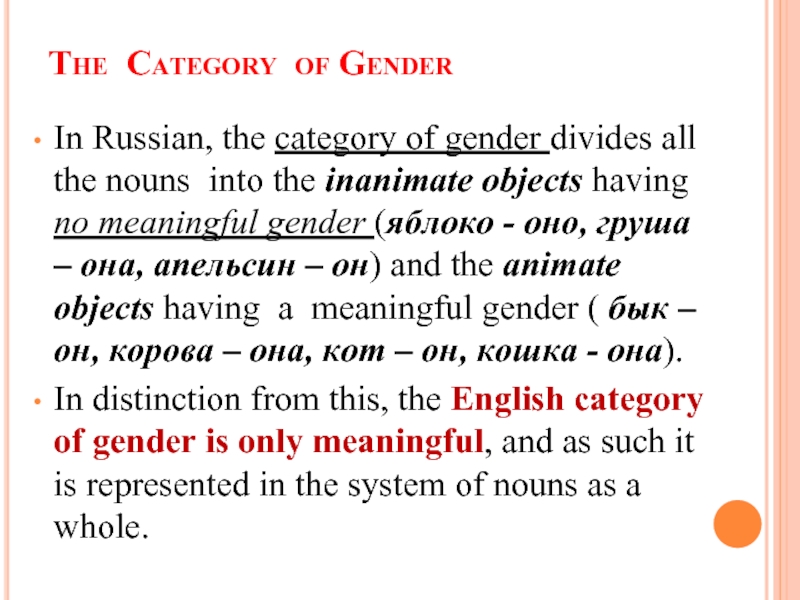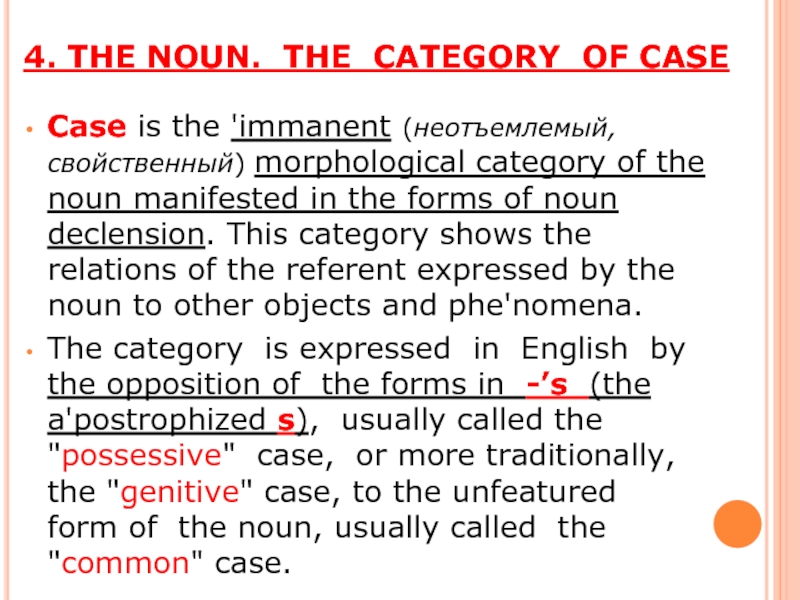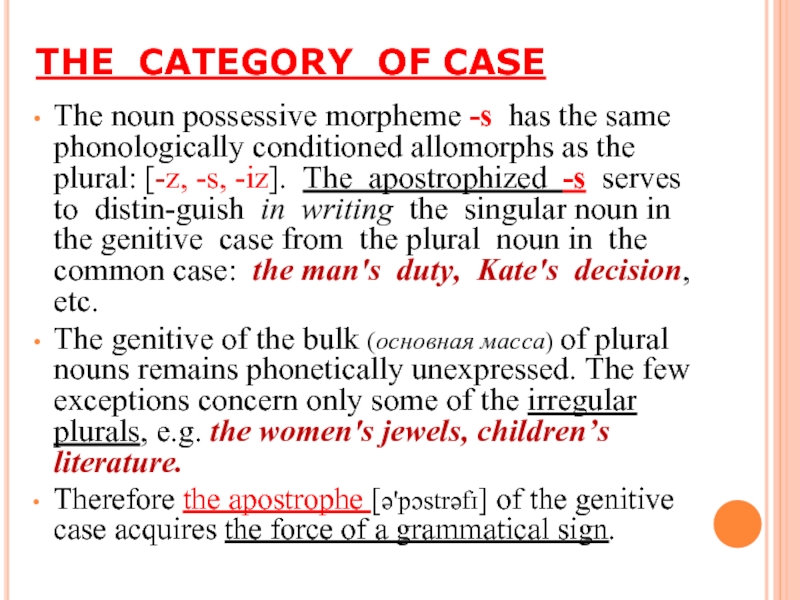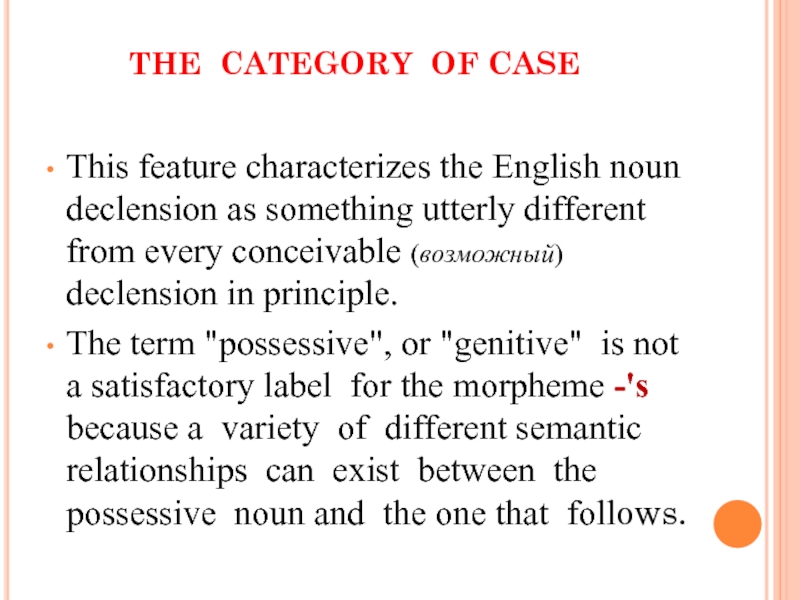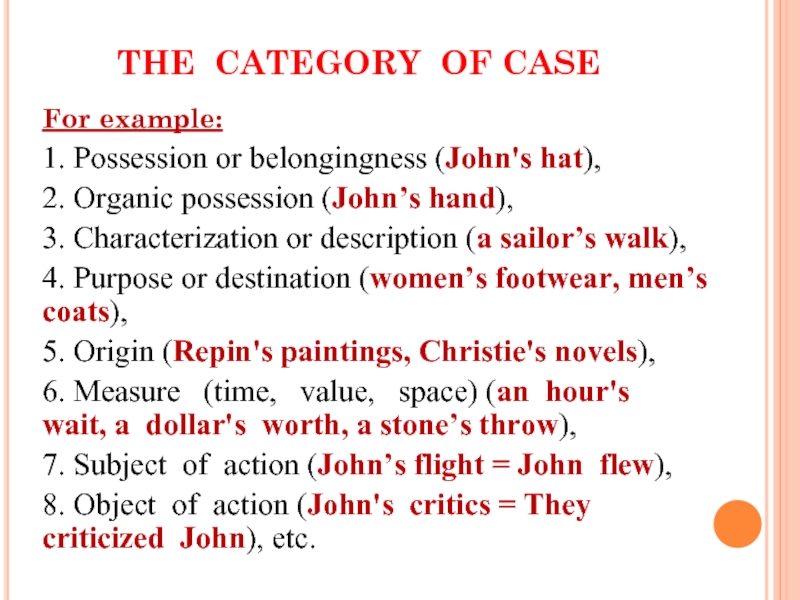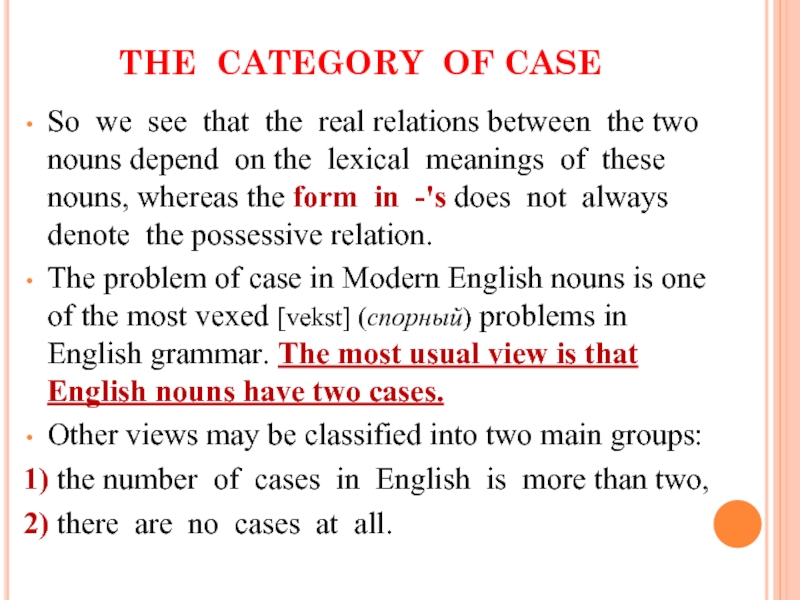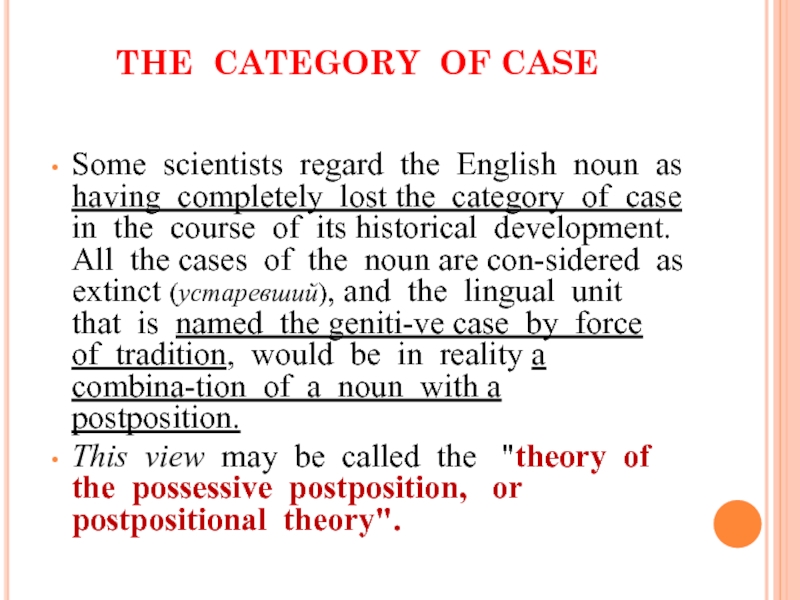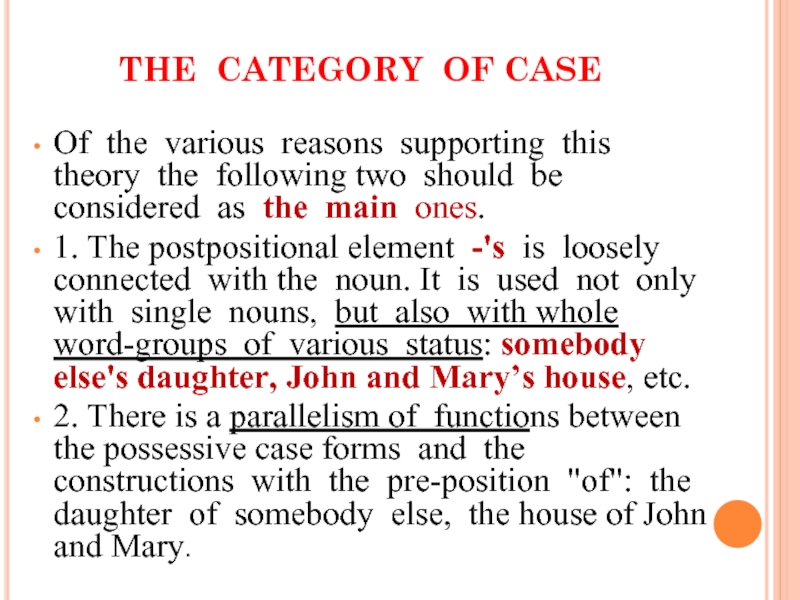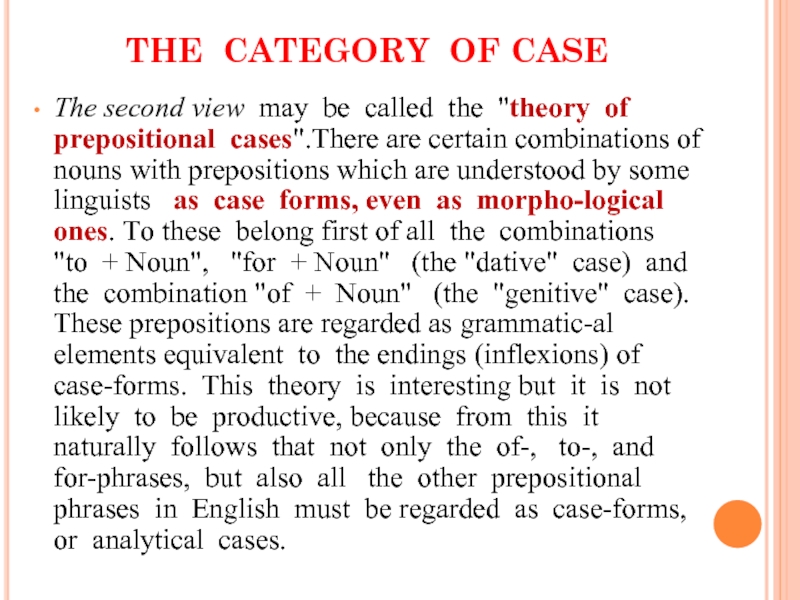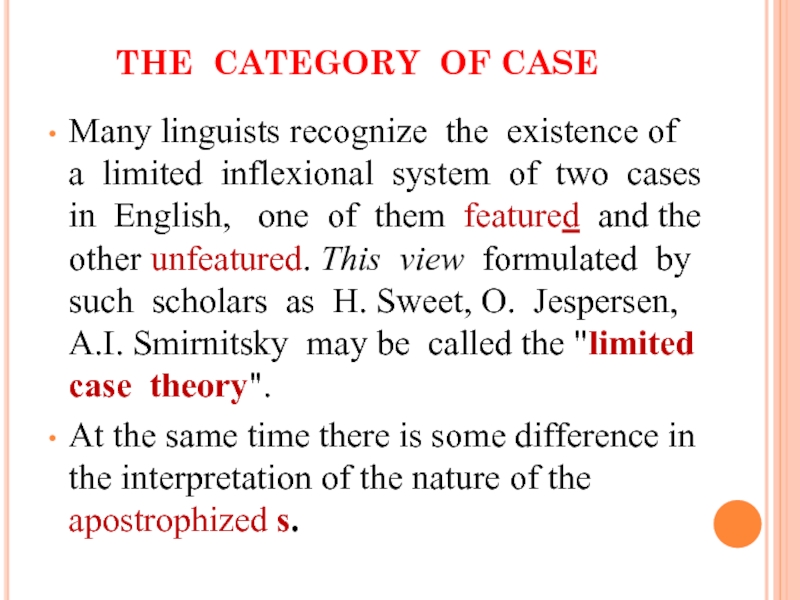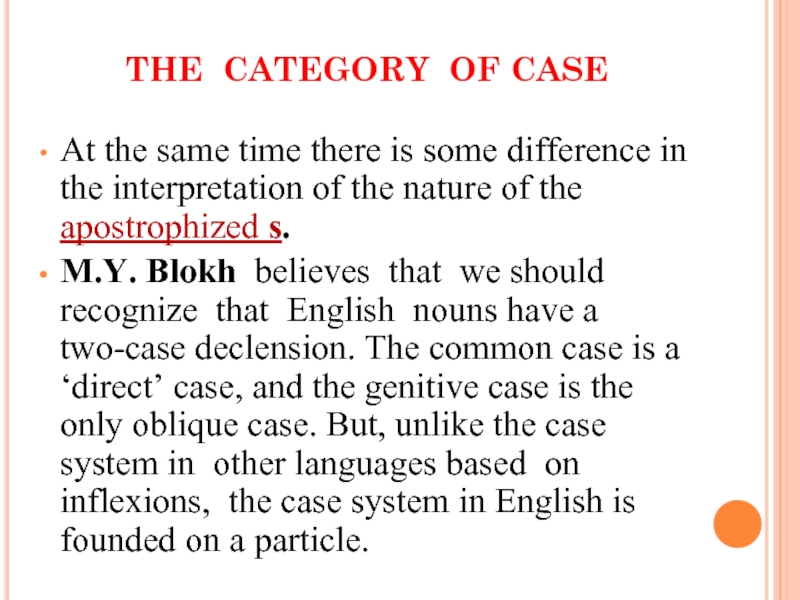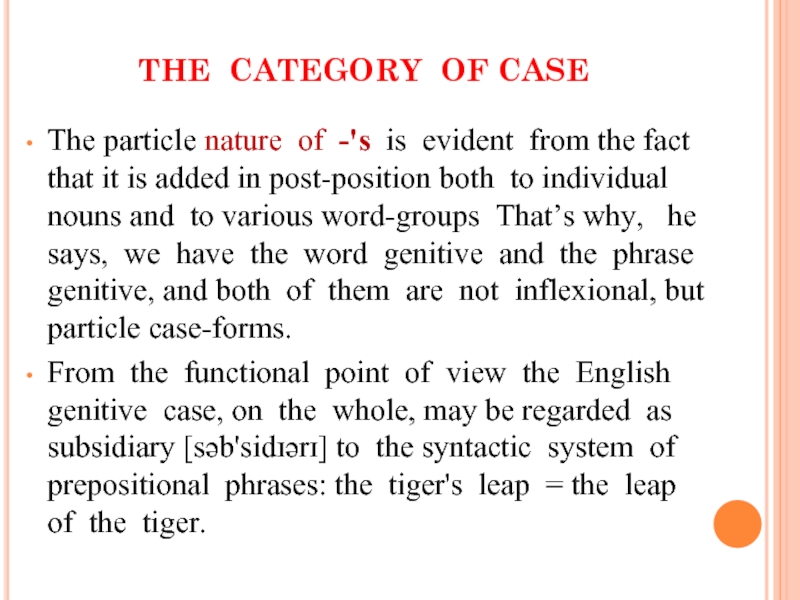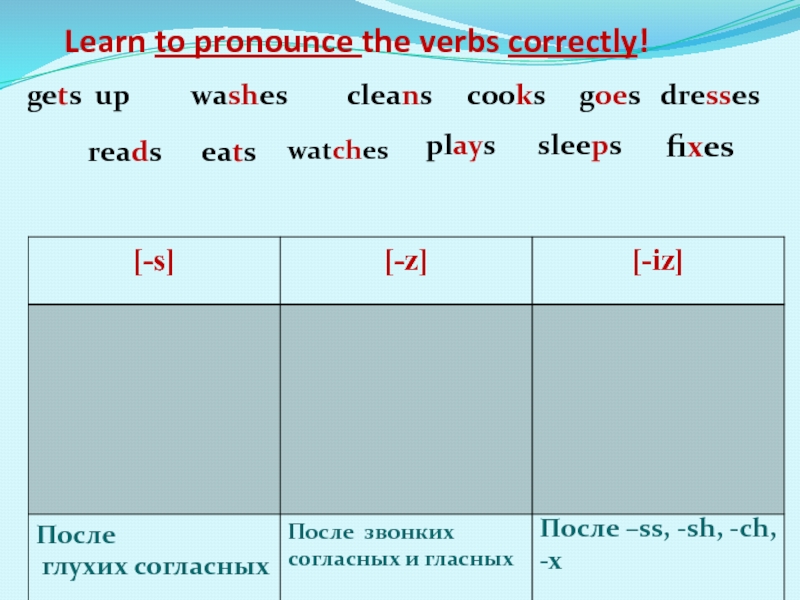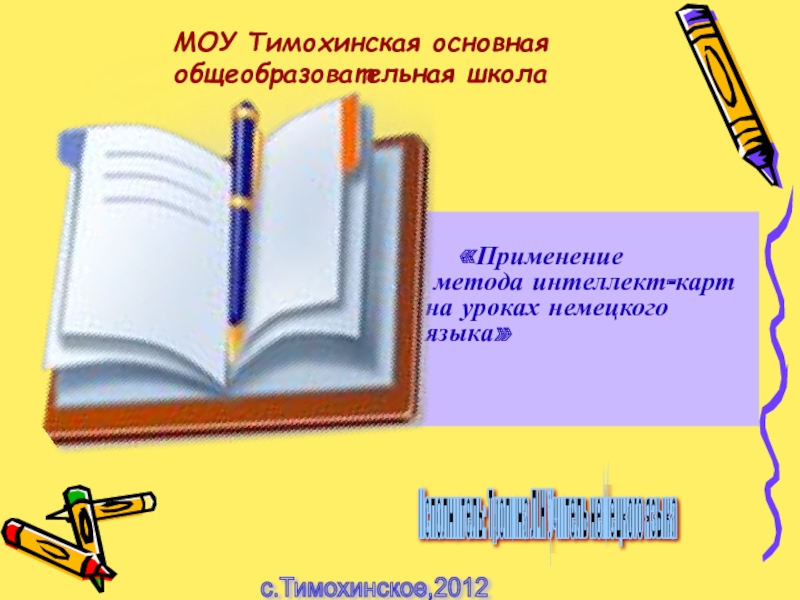- Главная
- Разное
- Дизайн
- Бизнес и предпринимательство
- Аналитика
- Образование
- Развлечения
- Красота и здоровье
- Финансы
- Государство
- Путешествия
- Спорт
- Недвижимость
- Армия
- Графика
- Культурология
- Еда и кулинария
- Лингвистика
- Английский язык
- Астрономия
- Алгебра
- Биология
- География
- Детские презентации
- Информатика
- История
- Литература
- Маркетинг
- Математика
- Медицина
- Менеджмент
- Музыка
- МХК
- Немецкий язык
- ОБЖ
- Обществознание
- Окружающий мир
- Педагогика
- Русский язык
- Технология
- Физика
- Философия
- Химия
- Шаблоны, картинки для презентаций
- Экология
- Экономика
- Юриспруденция
The noun as a part of speech презентация
Содержание
- 1. The noun as a part of speech
- 2. 1. THE NOUN: GENERAL 1. The noun
- 3. THE NOUN: GENERAL The categorial functional properties
- 4. THE NOUN: GENERAL It should be noted
- 5. THE NOUN: GENERAL Mary is a flower-girl.
- 6. THE NOUN: GENERAL Apart from the cited
- 7. THE NOUN: GENERAL The possessive combinability characterizes
- 8. THE NOUN: GENERAL As a part of
- 9. THE NOUN: GENERAL The cited formal features
- 10. THE NOUN: GENERAL The first nounal subclass
- 11. THE NOUN: GENERAL The fourth subclass opposition
- 12. THE NOUN: GENERAL The subclass differentiation of
- 13. THE NOUN: GENERAL In particular, the base
- 14. 2. The Category of
- 15. The Category of Number The other,
- 17. The Category of Number In the
- 18. The Category of Number The category
- 19. The Category of Number Nouns like
- 20. The Category of Number In the
- 21. The Category of Number Some of
- 22. The Category of Number Common number
- 23. The Category of Number The necessity
- 24. The Category of Number Singularia tantum
- 25. 3. The Category of Gender The
- 26. The Category of Gender The category of
- 27. The Category of Gender As a result
- 28. The Category of Gender The strong
- 29. The Category of Gender A great many
- 30. The Category of Gender Some English nouns
- 31. The Category of Gender On closer observation,
- 32. Boy Girl Wife Husband
- 33. The Category of Gender In Russian, the
- 34. 4. THE NOUN. THE CATEGORY OF CASE
- 35. THE CATEGORY OF CASE The noun possessive
- 36. THE CATEGORY OF CASE Functionally the forms
- 37. THE CATEGORY OF CASE This feature characterizes
- 38. THE CATEGORY OF CASE For example: 1.
- 39. THE CATEGORY OF CASE So we see
- 40. THE CATEGORY OF CASE Some scientists regard
- 41. THE CATEGORY OF CASE Of the various
- 42. THE CATEGORY OF CASE The second view
- 43. THE CATEGORY OF CASE Many linguists recognize
- 44. THE CATEGORY OF CASE At the same
- 45. THE CATEGORY OF CASE The particle nature
Слайд 21. THE NOUN: GENERAL
1. The noun as a part of speech
has the categorial meaning of "substance" (предмет).
It is the main nominative part of speech, representing nomination of the fullest value within the framework of the notional division of the lexicon.
The noun has the power, by way of nomination, to isolate different properties of substances and present them as corresponding self-dependent (самостоятельный, независимый) substances. E.g.:
Her words were unexpectedly bitter. - We were struck by the unexpected bitterness of her words.
It is the main nominative part of speech, representing nomination of the fullest value within the framework of the notional division of the lexicon.
The noun has the power, by way of nomination, to isolate different properties of substances and present them as corresponding self-dependent (самостоятельный, независимый) substances. E.g.:
Her words were unexpectedly bitter. - We were struck by the unexpected bitterness of her words.
Слайд 3THE NOUN: GENERAL
The categorial functional properties of the noun are determined
by its semantic properties.
The most characteristic substantive function of the noun is that of the subject in the sentence. The function of the object in the sentence is also typical of the noun as the substance word. Other syntactic functions, i.e. attributive, adverbial, and even predicative, although performed by the noun with equal ease, are not immediately characteristic of its substantive quality as such.
The most characteristic substantive function of the noun is that of the subject in the sentence. The function of the object in the sentence is also typical of the noun as the substance word. Other syntactic functions, i.e. attributive, adverbial, and even predicative, although performed by the noun with equal ease, are not immediately characteristic of its substantive quality as such.
Слайд 4THE NOUN: GENERAL
It should be noted that, while performing these non-substantive
functions, the noun essentially differs from the other parts of speech used in similar sentence positions. This may be clearly shown by transformations shifting the noun from various non-subject syntactic positions into subject syntactic positions of the same general semantic value, which is impossible with other parts of speech. E.g.:
Слайд 5THE NOUN: GENERAL
Mary is a flower-girl. - The flower-girl (you are
speaking of) is Mary. He lives in Glasgow. - Glasgow is his place of residence. This happened three years ago. - Three years have elapsed /ɪˈlæps/ (проходить, пролетать) since it happened.
Слайд 6THE NOUN: GENERAL
Apart from the cited sentence-part functions, the noun is
characterized by some special types of combinability.
In particular, typical of the noun is the prepositional combinability with another noun, a verb, an adjective, an adverb. E.g.: an entrance to the house; to turn round the corner; red in the face; far from its destination.
In particular, typical of the noun is the prepositional combinability with another noun, a verb, an adjective, an adverb. E.g.: an entrance to the house; to turn round the corner; red in the face; far from its destination.
Слайд 7THE NOUN: GENERAL
The possessive combinability characterizes the noun alongside its prepositional
combinability with another noun. E.g.: the speech of the President - the President's speech; the cover of the book - the book's cover.
English nouns can also easily combine with one another by sheer contact. E.g.: a cannon ball; a log cabin; a sports event; film festivals.
English nouns can also easily combine with one another by sheer contact. E.g.: a cannon ball; a log cabin; a sports event; film festivals.
Слайд 8THE NOUN: GENERAL
As a part of speech, the noun is also
characterized by a set of formal features determining its specific status in the lexical paradigm of nomination.
It has its word-building distinctions, including typical suffixes, compound stem models, conversion patterns.
It discriminates (выражает) the grammatical categories of gender, number, case, article determination.
It has its word-building distinctions, including typical suffixes, compound stem models, conversion patterns.
It discriminates (выражает) the grammatical categories of gender, number, case, article determination.
Слайд 9THE NOUN: GENERAL
The cited formal features taken together are relevant for
the division of nouns into several subclasses, which are identified by means of explicit (точный) classificational criteria. The most general and rigorously deˈlimited (определять границы; разграничивать) subclasses of nouns are grouped into four oppositional pairs.
Слайд 10THE NOUN: GENERAL
The first nounal subclass opposition differentiates proper (собственные) and
common (нарицательные) nouns.
The second subclass opposition differentiates animate /ˈænɪmət/ (одушевлённый) and inanimate nouns.
The third subclass opposition differentiates human and non-human nouns on the basis of "personal quality".
The second subclass opposition differentiates animate /ˈænɪmət/ (одушевлённый) and inanimate nouns.
The third subclass opposition differentiates human and non-human nouns on the basis of "personal quality".
Слайд 11THE NOUN: GENERAL
The fourth subclass opposition differentiates countable and uncountable nouns
on the basis of "quantitative structure".
Somewhat less exˈplicitly (детально) and rigorously (строго) distinguished is the division of English nouns into concrete and abstract.
The given set of eight subclasses cannot be structured hierarchically /ˌhaɪəˈrɑ:kɪk(ə)lɪ/ in any linguistically relevant sense (some sort of hierarchical relations can be observed only between animate - inanimate and human - non-human groupings).
Somewhat less exˈplicitly (детально) and rigorously (строго) distinguished is the division of English nouns into concrete and abstract.
The given set of eight subclasses cannot be structured hierarchically /ˌhaɪəˈrɑ:kɪk(ə)lɪ/ in any linguistically relevant sense (some sort of hierarchical relations can be observed only between animate - inanimate and human - non-human groupings).
Слайд 12THE NOUN: GENERAL
The subclass differentiation of nouns constitutes a foundation for
their selectional (сочетаемостная) syntagmatic combinability (совместимость) both among themselves and with other parts of speech. In the selectional aspect of combinability, the subclass features form the corresponding selectional bases.
Слайд 13THE NOUN: GENERAL
In particular, the base of combinability can be pointed
out between the noun subject and the verb predicate in the following sentences:
The sandstone (песчаник) was crumbling (сыпаться, осыпаться). (not: *The horse was crumbling.)
The horse was laming. (not: *The tree was laming.)
John was laughing (not: *The cat was laughing).
The sandstone (песчаник) was crumbling (сыпаться, осыпаться). (not: *The horse was crumbling.)
The horse was laming. (not: *The tree was laming.)
John was laughing (not: *The cat was laughing).
Слайд 14
2. The Category of Number
The category of number in English
is expressed by the opposition of the plural form of the noun (the strong member) to its singular form (the weak member). The productive formal mark of the plural form is the suffix -(e)s. This mark correlates /ˈkɒrɪleɪt/ (соотносится) with the absence of the number suffix in the singular.
Слайд 15The Category of Number
The other, non-productive ways of expressing the
number opposition are:
a) the change of vowels (tooth-teeth),
b) the archaic suffix -(e)n (ox-oxen),
c) the correlation of individual singular and plural suffixes in some borrowed nouns (phenomenon - phenomena; cactus - cacti /ˈkæktaɪ/, formula – formulae /ˈfɔ:mju:li:/ ).
In some cases the plural form is homonymous with the singular form (sheep).
a) the change of vowels (tooth-teeth),
b) the archaic suffix -(e)n (ox-oxen),
c) the correlation of individual singular and plural suffixes in some borrowed nouns (phenomenon - phenomena; cactus - cacti /ˈkæktaɪ/, formula – formulae /ˈfɔ:mju:li:/ ).
In some cases the plural form is homonymous with the singular form (sheep).
Слайд 17The Category of Number
In the plural linguists distinguish the following
semantic variants:
1) plural of separate objects (one book - two books; one potato - two potatoes);
2) plural of material (potato > one object - potatoes > food);
3) plural of measure (one mile - two miles);
4) plural of a definite set of objects (wheels of the car, eyes/lips of the face, etc.);
5) plural of various types of the referent (French wines, Indian teas);
6) emotional usage (sands, waters, snows: the waters of the Pacific Ocean), etc.
1) plural of separate objects (one book - two books; one potato - two potatoes);
2) plural of material (potato > one object - potatoes > food);
3) plural of measure (one mile - two miles);
4) plural of a definite set of objects (wheels of the car, eyes/lips of the face, etc.);
5) plural of various types of the referent (French wines, Indian teas);
6) emotional usage (sands, waters, snows: the waters of the Pacific Ocean), etc.
Слайд 18The Category of Number
The category of number is one of
the regular variable /ˈvɛərɪəbl/ categories in the grammatical system of English.
All nouns are divided into two groups: 'countables and uncountables. The first group of nouns has number opposites /ˈɒpəzɪts/, the second has not.
Uncountable nouns are subdivided into those having no plural forms and those having no singular forms.
All nouns are divided into two groups: 'countables and uncountables. The first group of nouns has number opposites /ˈɒpəzɪts/, the second has not.
Uncountable nouns are subdivided into those having no plural forms and those having no singular forms.
Слайд 19The Category of Number
Nouns like "milk", "geometry", "friendliness" having no
plural opposites are called by a Latin name, SINGULARIA TANTUM (only singular). Nouns like "clothes", "goods" having no singular opposites are known as PLURALIA TANTUM (only plural).
Слайд 20The Category of Number
In the two subclasses of uncountable nouns
the number opposition is reduced either to the weak member or to the strong one. It is possible to speak of the absolute singular (milk, geometry), as different from the common singular of the countable nouns, and of the absolute plural (clothes, trousers, scissors; police), as different from the common plural of the countable nouns.
Слайд 21The Category of Number
Some of the absolute singular words can
be used in the form of the common singular with the common plural counterpart (аналог). In this case they come to mean
a) different sorts of materials (teas, steels);
b) separate 'concrete manifestations of the qualities denoted by abstract nouns (kindnesses - услуги; the joys of life);
c) concrete objects exhibiting the respective qualities (copper - медь, coppers - медяки).
a) different sorts of materials (teas, steels);
b) separate 'concrete manifestations of the qualities denoted by abstract nouns (kindnesses - услуги; the joys of life);
c) concrete objects exhibiting the respective qualities (copper - медь, coppers - медяки).
Слайд 22The Category of Number
Common number with some uncountable singular nouns
can also be expressed by combining them with such words as "bit", "piece", "item", "sort": advice - absolute sg, a piece of advice - common sg., two pieces of advice - common pl. This kind of expressing the grammatical meaning of common number is regarded as special suppletivity in the category of number.
Слайд 23The Category of Number
The necessity of expressing definite numbers in
cases of uncountable pluralia tantum nouns has brought about different combinations, e.g. trousers – absolute pl., a pair of trousers – common sg., two pairs of trousers – common pl., police – absolute pl., two groups (teams) of police – common pl.
This kind of expressing the grammatical meaning of common number is also regarded as suppletivity.
This kind of expressing the grammatical meaning of common number is also regarded as suppletivity.
Слайд 24The Category of Number
Singularia tantum forms are treated as singulars,
and pluralia tantum as plurals. But when combinability (совместимость, сочетаемость ) and form contradict each other, combinability is decisive /dɪˈsaɪsɪv/ (имеющий решающее значение), so "police", "cattle" are regarded as plurals, and "measles", "linguistics" as singulars.
Слайд 253. The Category of Gender
The problem of gender is not
a simple one. Many grammarians define the category of gender in English as purely lexical or "semantic".
The most complete description of this phenomenon is given in 'A Course in Theoretical English Grammar' by M.Y. Blokh. He believes that the category of gender is expressed in English by the obligatory correlation of nouns with the personal pronouns of the third person, singular. These serve as specific gender classifiers of nouns.
The most complete description of this phenomenon is given in 'A Course in Theoretical English Grammar' by M.Y. Blokh. He believes that the category of gender is expressed in English by the obligatory correlation of nouns with the personal pronouns of the third person, singular. These serve as specific gender classifiers of nouns.
Слайд 26The Category of Gender
The category of gender is strictly oppositional. It
is formed by two oppositions. 1) One opposition functions in the whole set of nouns, dividing them into person (human) nouns and non-person (non-human) nouns. 2) The other opposition functions in the subset of person nouns only, dividing them into masculine nouns and feminine nouns. Thus, the first opposition can be regarded as the upper opposition in the category of gender, while the second one as the lower opposition in this category.
Слайд 27The Category of Gender
As a result of the double oppositional correlation,
a specific system of three genders arises, which is represented by the traditional terminology: the neuter (non-person) gender, the masculine (masculine person) gender, the feminine (feminine person) gender.
In the upper opposition the strong member is the human subclass of nouns (‘person’, ‘personality’). The weak member of the opposition comprises both inanimate and animate /ˈænɪmət/ non-person nouns (tree, marriage, desk; cat, ant, bull, cow, cock, hen, etc.). Non-person nouns are replaced by "it".
In the upper opposition the strong member is the human subclass of nouns (‘person’, ‘personality’). The weak member of the opposition comprises both inanimate and animate /ˈænɪmət/ non-person nouns (tree, marriage, desk; cat, ant, bull, cow, cock, hen, etc.). Non-person nouns are replaced by "it".
Слайд 28The Category of Gender
The strong member of
the lower opposition is the feminine subclass of person nouns ("female sex"). Here belong such nouns as 'woman', 'girl', 'mother', ‘sister’, 'bride', etc. The masculine subclass of person nouns (man, boy, father, bridegroom, etc.) makes up the weak member of the opposition, because if there is no special need to indicate the sex of a person or we are not sure about it, we define the person as "he".
The linguists who recognize the existence of gender in English usually distinguish four genders, though they are not indicated by inflective forms.
The linguists who recognize the existence of gender in English usually distinguish four genders, though they are not indicated by inflective forms.
Слайд 29The Category of Gender
A great many person nouns in English are
capable of expressing both feminine and masculine person genders: parent, person, cousin, doctor, teacher, president, etc. These are referred to as nouns of the "common gender".
Слайд 30The Category of Gender
Some English nouns can show sex lexically, 1)either
by means of being combined with certain words used as sex indicators (boy-friend, girl-friend, signalman, signalwoman, landlord, landlady, cock-sparrow, hen-sparrow, he-bear, she-bear), or 2) else by suffixal derivation (master, mistress, actor, actress, etc.). One might think that this kind of expressing sex contradicts the above given gender system of nouns, since (так как) the sex distinctions expressed in the given pairs of words refer not only to people (persons), but also to other animate beings.
Слайд 31The Category of Gender
On closer observation, however, we see that this
is not at all so. In fact, the referents of such nouns as "cock-sparrow", or "hen-sparrow", or the like, can be quite naturally represented by the pronoun "it", while the representation of such nouns as "boy", "girl" is different – only "he", and "she". Even the word combinations ‘he-bear’ and ‘she-bear’ express a feature related to sex, not gender. If these sex distinctions are not important, both may be defined as “it”
Слайд 33The Category of Gender
In Russian, the category of gender divides all
the nouns into the inanimate objects having no meaningful gender (яблоко - оно, груша – она, апельсин – он) and the animate objects having a meaningful gender ( бык – он, корова – она, кот – он, кошка - она).
In distinction from this, the English category of gender is only meaningful, and as such it is represented in the system of nouns as a whole.
In distinction from this, the English category of gender is only meaningful, and as such it is represented in the system of nouns as a whole.
Слайд 344. THE NOUN. THE CATEGORY OF CASE
Case is the 'immanent (неотъемлемый,
свойственный) morphological category of the noun manifested in the forms of noun declension. This category shows the relations of the referent expressed by the noun to other objects and phe'nomena.
The category is expressed in English by the opposition of the forms in -’s (the a'postrophized s), usually called the "possessive" case, or more traditionally, the "genitive" case, to the unfeatured form of the noun, usually called the "common" case.
The category is expressed in English by the opposition of the forms in -’s (the a'postrophized s), usually called the "possessive" case, or more traditionally, the "genitive" case, to the unfeatured form of the noun, usually called the "common" case.
Слайд 35THE CATEGORY OF CASE
The noun possessive morpheme -s has the same
phonologically conditioned allomorphs as the plural: [-z, -s, -iz]. The apostrophized -s serves to distinguish in writing the singular noun in the genitive case from the plural noun in the common case: the man's duty, Kate's decision, etc.
The genitive of the bulk (основная масса) of plural nouns remains phonetically unexpressed. The few exceptions concern only some of the irregular plurals, e.g. the women's jewels, children’s literature.
Therefore the apostrophe [ə'pɔstrəfɪ] of the genitive case acquires the force of a grammatical sign.
The genitive of the bulk (основная масса) of plural nouns remains phonetically unexpressed. The few exceptions concern only some of the irregular plurals, e.g. the women's jewels, children’s literature.
Therefore the apostrophe [ə'pɔstrəfɪ] of the genitive case acquires the force of a grammatical sign.
Слайд 36THE CATEGORY OF CASE
Functionally the forms of the English nouns which
are considered to be "case forms" relate to one another in an extremely peculiar way: 1) the common case form is absolutely indefinite from the semantic point of view, whereas the genitive form is restricted to the functions which have a parallel expression by prepositional constructions (esp. an of-phrase). 2)The common case form is also capable of rendering the genitive semantics (namely, in contact and prepositional combinations), which makes the whole of the genitive case into a kind of subsidiary /səbˈsɪdɪərɪ/ (дополнительный, побочный, вспомогательный) element in the grammatical system of the English noun.
Слайд 37THE CATEGORY OF CASE
This feature characterizes the English noun declension as
something utterly different from every conceivable (возможный) declension in principle.
The term "possessive", or "genitive" is not a satisfactory label for the morpheme -'s because a variety of different semantic relationships can exist between the possessive noun and the one that follows.
The term "possessive", or "genitive" is not a satisfactory label for the morpheme -'s because a variety of different semantic relationships can exist between the possessive noun and the one that follows.
Слайд 38THE CATEGORY OF CASE
For example:
1. Possession or belongingness (John's hat),
2. Organic
possession (John’s hand),
3. Characterization or description (a sailor’s walk),
4. Purpose or destination (women’s footwear, men’s coats),
5. Origin (Repin's paintings, Christie's novels),
6. Measure (time, value, space) (an hour's wait, a dollar's worth, a stone’s throw),
7. Subject of action (John’s flight = John flew),
8. Object of action (John's critics = They criticized John), etc.
3. Characterization or description (a sailor’s walk),
4. Purpose or destination (women’s footwear, men’s coats),
5. Origin (Repin's paintings, Christie's novels),
6. Measure (time, value, space) (an hour's wait, a dollar's worth, a stone’s throw),
7. Subject of action (John’s flight = John flew),
8. Object of action (John's critics = They criticized John), etc.
Слайд 39THE CATEGORY OF CASE
So we see that the real relations between
the two nouns depend on the lexical meanings of these nouns, whereas the form in -'s does not always denote the possessive relation.
The problem of case in Modern English nouns is one of the most vexed [vekst] (спорный) problems in English grammar. The most usual view is that English nouns have two cases.
Other views may be classified into two main groups:
1) the number of cases in English is more than two,
2) there are no cases at all.
The problem of case in Modern English nouns is one of the most vexed [vekst] (спорный) problems in English grammar. The most usual view is that English nouns have two cases.
Other views may be classified into two main groups:
1) the number of cases in English is more than two,
2) there are no cases at all.
Слайд 40THE CATEGORY OF CASE
Some scientists regard the English noun as having
completely lost the category of case in the course of its historical development. All the cases of the noun are considered as extinct (устаревший), and the lingual unit that is named the genitive case by force of tradition, would be in reality a combination of a noun with a postposition.
This view may be called the "theory of the possessive postposition, or postpositional theory".
This view may be called the "theory of the possessive postposition, or postpositional theory".
Слайд 41THE CATEGORY OF CASE
Of the various reasons supporting this theory the
following two should be considered as the main ones.
1. The postpositional element -'s is loosely connected with the noun. It is used not only with single nouns, but also with whole word-groups of various status: somebody else's daughter, John and Mary’s house, etc.
2. There is a parallelism of functions between the possessive case forms and the constructions with the preposition "of": the daughter of somebody else, the house of John and Mary.
1. The postpositional element -'s is loosely connected with the noun. It is used not only with single nouns, but also with whole word-groups of various status: somebody else's daughter, John and Mary’s house, etc.
2. There is a parallelism of functions between the possessive case forms and the constructions with the preposition "of": the daughter of somebody else, the house of John and Mary.
Слайд 42THE CATEGORY OF CASE
The second view may be called the "theory
of prepositional cases".There are certain combinations of nouns with prepositions which are understood by some linguists as case forms, even as morphological ones. To these belong first of all the combinations "to + Noun", "for + Noun" (the "dative" case) and the combination "of + Noun" (the "genitive" case). These prepositions are regarded as grammatical elements equivalent to the endings (inflexions) of case-forms. This theory is interesting but it is not likely to be productive, because from this it naturally follows that not only the of-, to-, and for-phrases, but also all the other prepositional phrases in English must be regarded as case-forms, or analytical cases.
Слайд 43THE CATEGORY OF CASE
Many linguists recognize the existence of a limited
inflexional system of two cases in English, one of them featured and the other unfeatured. This view formulated by such scholars as H. Sweet, O. Jespersen, A.I. Smirnitsky may be called the "limited case theory".
At the same time there is some difference in the interpretation of the nature of the apostrophized s.
At the same time there is some difference in the interpretation of the nature of the apostrophized s.
Слайд 44THE CATEGORY OF CASE
At the same time there is some difference
in the interpretation of the nature of the apostrophized s.
M.Y. Blokh believes that we should recognize that English nouns have a two-case declension. The common case is a ‘direct’ case, and the genitive case is the only oblique case. But, unlike the case system in other languages based on inflexions, the case system in English is founded on a particle.
M.Y. Blokh believes that we should recognize that English nouns have a two-case declension. The common case is a ‘direct’ case, and the genitive case is the only oblique case. But, unlike the case system in other languages based on inflexions, the case system in English is founded on a particle.
Слайд 45THE CATEGORY OF CASE
The particle nature of -'s is evident from
the fact that it is added in post-position both to individual nouns and to various word-groups That’s why, he says, we have the word genitive and the phrase genitive, and both of them are not inflexional, but particle case-forms.
From the functional point of view the English genitive case, on the whole, may be regarded as subsidiary [səb'sidɪərɪ] to the syntactic system of prepositional phrases: the tiger's leap = the leap of the tiger.
From the functional point of view the English genitive case, on the whole, may be regarded as subsidiary [səb'sidɪərɪ] to the syntactic system of prepositional phrases: the tiger's leap = the leap of the tiger.
